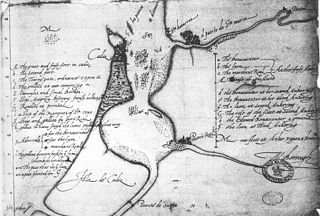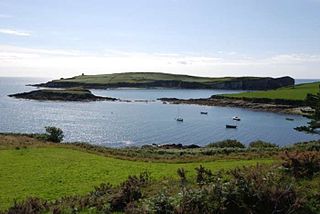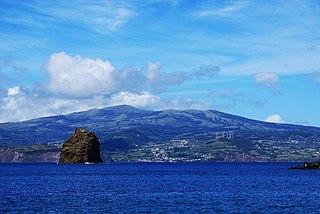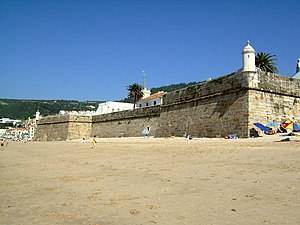
Galleons were large, multi-decked sailing ships developed in Spain and first used as armed cargo carriers by Europeans from the 16th to 18th centuries during the age of sail and were the principal vessels drafted for use as warships until the Anglo-Dutch Wars of the mid-1600s. Galleons generally carried three or more masts with a lateen fore-and-aft rig on the rear masts, were carvel built with a prominent squared off raised stern, and used square-rigged sail plans on their fore-mast and main-masts.
Vice-Admiral Sir William Monson was an English admiral and politician who sat in the House of Commons in 1601.

The Anglo-Spanish War (1585–1604) was an intermittent conflict between the Habsburg Kingdom of Spain and the Kingdom of England. It was never formally declared. The war included much English privateering against Spanish ships, and several widely separated battles. It began with England's military expedition in 1585 to what was then the Spanish Netherlands under the command of the Earl of Leicester, in support of the Dutch rebellion against Spanish Habsburg rule.
Dreadnought was a 41-gun galleon of the Tudor navy, built by Mathew Baker and launched in 1573. Like HMS Dreadnought of 1906, she was a radical innovation over contemporary ships. When John Hawkins became Treasurer of the Navy in 1577, he had sailed all over the world, and his ideas contributed to the production of a new race-built series of galleons—of which Dreadnought was the second, following Foresight of 1570—without the high forecastle and aftcastle prevalent in earlier galleons. These "marvels of marine design" could reputedly "run circles around the clumsier Spanish competition."

The naval Battle of Vila Franca do Campo, also known as Battle of Ponta Delgada and Naval Battle of Terceira Island, took place on 26 July 1582, off the coast of the island of São Miguel in the Portuguese archipelago of the Azores, during the War of the Portuguese Succession. A combined corsair expedition, mainly French, sailed against a Spanish naval force made up of Portuguese and Castilian ships, to preserve control of the Azores under pretender António, Prior of Crato and to defend the islands from incorporation into the Iberian Union—the largest French force sent overseas before the age of Louis XIV.

The Ottoman–Portuguese Conflicts (1586–1589) were armed military engagements which took place between the Portuguese Empire and the Ottoman Empire along the coast of eastern Africa. The conflict resulted from the expansion of the Portuguese Empire into territory controlled by the Adal Sultanate.

Warspite was a great ship of the English Tudor navy. The vessel was built at Deptford Dockyard by the master shipwright Edward Stevens and launched about 1 March 1596. She carried a crew of 300 when at sea, of whom 190 were classed as "mariners", manning the guns and fighting the ship; 80 as "sailors", working the sails and ancestors of present-day seamen and 30 "gunners", the armament specialists.

Singeing the King of Spain's Beard is the derisive name given to a series of attacks by the English privateer Francis Drake against the Spanish in the summer of 1587, beginning in April with a raid on Cádiz. This was an attack on the Spanish naval forces assembling in the Bay of Cádiz in preparation for the planned expedition against England. Much of the Spanish fleet was destroyed, and substantial supplies were destroyed or captured. There followed a series of raiding parties against several forts along the Portuguese coast. A Spanish treasure ship, returning from the Indies, was also captured. The damage caused by the English delayed Spanish preparations for the Armada by at least a year.

The Battle of Berlengas Islands was a naval battle which took place off the Portuguese coast on 15 July 1591, during the war between Elizabeth I of England and Philip II of Spain. It was fought between an English privateer squadron under George Clifford, 3rd Earl of Cumberland, who had set out his fortunes by large-scale privateering, and a squadron of 5 Spanish galleys commanded by Francisco Coloma tasked with patrolling the Portuguese coast against privateers. While anchored off the Berlengas, the English ships were surprised by the Spanish galleys, which succeeded in taking one English ship and rescuing two prizes.

Álvaro de Bazán, 2nd Marquess of Santa Cruz, a.k.a. Álvaro de Bazán y Benavides, a.k.a. Alvaro II de Bazán,, was the son of Álvaro de Bazán, 1st Marquess of Santa Cruz.

The Conquest of the Azores, but principally involving the conquest of the island of Terceira, occurred on 2 August 1583, in the Portuguese archipelago of the Azores, between forces loyal to the claimant D. António, Prior of Crato, supported by the French and English troops, and the Spanish and Portuguese forces loyal to King Philip II of Spain, commanded by the Admiral Don Álvaro de Bazán, Marquis of Santa Cruz, during the War of the Portuguese Succession. The victory of the Marquis of Santa Cruz resulted in the rapid Spanish conquest of the Azores, facilitating the integration of the Kingdom of Portugal and its colonial possessions into the Spanish Empire.

The Battle of Castlehaven was a naval battle that took place on 6 December 1601 in the bay off Castlehaven on the south coast of Ireland during the Nine Years' War between a Spanish naval convoy of six ships and an English fleet, commanded by Admiral Richard Leveson and consisting of four warships. The Spanish convoy was protected by fortified positions on shore, a castle, and 600 Spanish and Irish footmen. Five out of six Spanish ships, commanded by General Pedro de Zubiaur were either sunk, captured, or run aground in the battle, while the English fleet lost no ships.

Sir Richard Leveson was an important Elizabethan Navy officer, politician and landowner. His origins were in the landed gentry of Shropshire and Staffordshire. A client and son-in-law of Charles Howard, 1st Earl of Nottingham, he became Vice-Admiral under him. He served twice as MP for Shropshire in the English parliament. He was ruined by the burden of debt built up by his father.

The Battle of the Narrow Seas, also known as the Battle of the Goodwin Sands or Battle of the Dover Straits was a naval engagement that took place on 3–4 October 1602 during the Anglo-Spanish War of 1585 and part of the Dutch Revolt. An English fleet under Sir Robert Mansell intercepted and attacked six Spanish galleys under the command of Federico Spinola in the Dover Straits. The battle was fought initially off the coast of England and finally off the Spanish Netherlands. The English were soon joined by a Dutch fleet under Jan Adriaanszoon Cant, and they completed the destruction.

The Battle of Flores (1592), also known as Cruising Voyage to the Azores of 1592, or the Capture of the Madre de Deus describes a series of naval engagements that took place from 20 May to 19 August 1592, during the Anglo-Spanish War. The battle was part of an expedition by an English fleet initially led by Sir Walter Raleigh, and then by Martin Frobisher and John Burrough. The expedition involved the capture of a number of Portuguese and Spanish ships including the large Portuguese carrack Madre de Deus, after a long naval battle off the island of Flores in the Azores. The expedition, particularly the capture of the great carrack, was a financial and military success. The rich cargo aboard the carrack, which at the time equaled nearly half the size of the Kingdom of England's royal annual revenue, was subject to mass theft when it arrived in Dartmouth, England, followed by quarrels over the shares of the prize. The expedition had formative consequences for the English both financially and on the future of English exploration.

The action of Faial or the Battle of Faial Island was a naval engagement that took place on 22–23 June 1594 during the Anglo-Spanish War in which the large and rich 2,000 ton Portuguese carrack Cinco Chagas was destroyed by an English fleet after a long and bitter battle off Faial Island in the Azores. The carrack, which was reputedly one of the richest ever to set sail from the Indies, was lost in an explosion which denied the English, as well as the Portuguese and Spanish, the riches.

The Capture of Recife also known as James Lancaster's 1595 Expedition or Lancaster's Pernambucan expedition was an English military expedition during the Anglo–Spanish War in which the primary objective was the capture of the town and port of Recife in the Captaincy of Pernambuco in the Portuguese colony of Brazil in April 1595. An English expedition of ships led by James Lancaster sailed via the Atlantic capturing numerous prizes before he captured Recife. He held the place for nearly a month and then proceeded to defeat a number of Portuguese counterattacks before leaving. The booty captured was substantial, Lancaster chartered Dutch and French ships that were also present there thus making the expedition a military and financial success.

Federico Spinola (1571–1603) was an Italian naval commander in Spanish Habsburg service during the Dutch Revolt.

The Azores Voyage of 1589, also known as Cumberland's Third Voyage, was a series of conflicts in the Azores islands between August and September 1589 by an English military joint stock expedition led by George Clifford, 3rd Earl of Cumberland, during the Anglo–Spanish War. All the islands were attacked either for provisions or the attainment of Spanish and Portuguese prizes. A number of Portuguese and Spanish ships were captured and also included a battle at Faial which resulted in the capture of the fort and the main town, which was subsequently sacked and burned. The English were able to return home unmolested with a total of thirteen prizes – the expedition was a success and with a good profit for the investors although many people died to disease and storms.




















